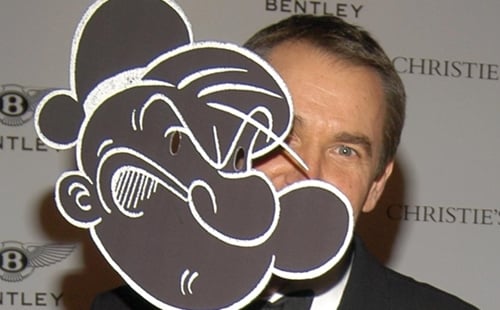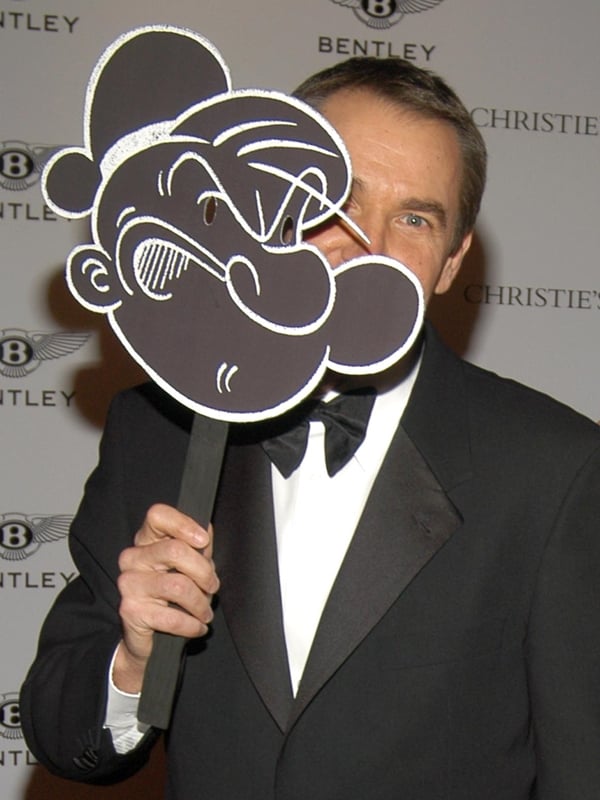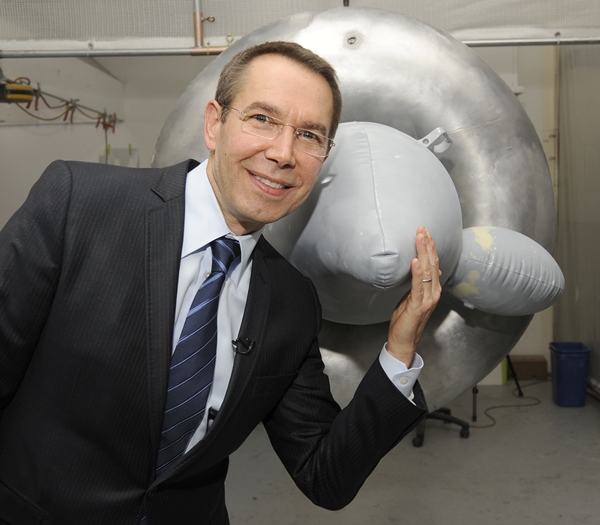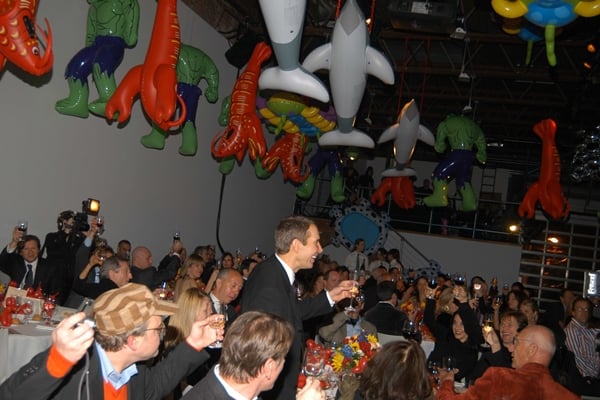Art & Exhibitions
The Wisdom of Jeff Koons in 6 Easy Quotes
1987: "I don't feel that the galleries truly care."

1987: "I don't feel that the galleries truly care."

Artnet News


Jeff Koons hiding behind a Popeye mask.
Photo: © 2014 Patrick McMullan Company, Inc.
This week is Koons Week New York, with Split-Rocker being unveiled at Rockefeller Center tomorrow and the Whitney Museum’s Koons retrospective opening on Friday the 27th. In honor of the festivities, we present the man, the artist, in his own words.
2012: BlouinArtInfo, upon the occasion of a show at Galerie Almine Rech, Brussels, commenting upon his Balloon Venus (Magenta) (2008–2012) and the Venus of Willendorf as his inspiration
Jeff Koons: If you walk around the piece, you can look inside the Venus and everything is revealed; so there’s a little aspect of violence, nothing is held back of her inner being. . . . It’s kind of a view of the cosmos. You have two crescent moons and you realize that it’s somebody having sex, there’s kind of a masculine-feminine presence, but it is only one person and they’re actually having sex with themselves. The Venus of Willendorf is truly a symbol of fertility because it can procreate on its own. The Venus’s breasts are full, they’re voluptuous, her stomach, a real symbol of fertility. But if you look and you let your mind start to go, you realize that the breasts could actually be testicles and that the stomach could actually be a phallus and that it’s actually going in on itself, and procreating.
2011: Tate Etc. issue 22, on the subject of René Magritte
Jeff Koons: Whenever I drive in any mountainous region in the world and look at the line against the sky, I always think of Magritte. And whenever I see beautiful, perfect clouds in the sky, he’s the first thing that comes to mind. . . .
I love the wide range of Magritte’s art, including his sculptures. One of the most profound pieces of his that I’ve always enjoyed is Discovery (1928). It is an image of a woman whose flesh resembles the grains in wood. There is this aspect of Magritte about dealing with the world around us, and there is a certain materiality, a reality about that world that he creates, even though he makes these strange juxtapositions. There is always a sense of confrontation in his work too.
It is hard to imagine a lot of the computer programs that we work with in daily life, such as Photoshop, without the influence of Magritte. The many ways that we see the world through transparency or gradation, I believe we owe to Magritte. So I hold him in very high esteem for showing us how images can be overlapped on each other, or how they can be gradated into each other.
2009: Interview magazine
Jeff Koons: I believe in sensuality. I believe in sex. I believe in the survival of the species. I like aspects of things that are ethereal, but I like the reality of nature and embracing the way nature works, and aspects of interrelationships between male-female, aspects of the body, the way the body has changed over thousands of years . . . most of the morning I was looking at the Venus of Willendorf.
David Colman: Okay.
Jeff Koons: This is a swan. [Koons holds up a small balloon-swan form] This swan is very totemic, very phallic. But if you look at the side view of the swan, it’s all a very sexual harmony and then the inside’s totally feminine and vaginal—and so it functions. Beauty is really sexualized. For me it was an epiphany, looking at this on the computer, two-dimensionally. I enjoy things that have a lot of layers to them and are connected. Anything that is connecting and that has a lot of different layers I become curious then . . .

Jeff Koons at his studio.
Photo: © 2014 Patrick McMullan Company, Inc.
1992: Jeff Koons, edited by John Caldwell et al. (San Francisco: San Francisco Museum of Modern Art, 1992)
Jeff Koons: I’ve always tried to use materialism to seduce the viewer and to try to meet the needs of the viewer, just like the church uses materialism. Every industry uses it, but the church is the great master and a great manipulator of materialism. If somebody walks into a church and they’re hungry and they do not feel secure with their own economic position in the world, they’re not in a position in the world, they’re not in a position to have a spiritual experience. So the church uses the Baroque and the Rococo, you just go in there and you feel like you’re participating in social mobility. This is how the Baroque and the Rococo were used; so that the public felt their needs were being met. I’ve always tried to do the same thing with my works.
1987: Flash Art 132 (the interview was conducted December 10, 1986)
Giancarlo Politi: You are making very new and aggressive art. . . . how do you fit into the New York situation? Do you look at other artists, or talk with them, or do you work alone?
Jeff Koons: I’ve been in New York since the end of ’76, but have been participating in an open dialogue with the community only since ’79. Until recently I have felt like an outsider, although I have always been directly connected with the center of the art community. I don’t feel like an outsider right now; if anything I have to impose an outside position. I live down in the Wall Street area only for exclusion, so that I don’t have to walk out on the street and be confronted with SoHo or run into a specific dealer, and so on.
Giancarlo Politi: What do you think the future of the art market in America will be like? Do you think galleries should change their strategies over the next ten years, in the light of developments like the recent boom in corporate art buying?
Jeff Koons: I believe the responsibility of art must be controlled by the artist. I don’t feel that the galleries truly care, or can be placed in a position to assume the responsibilities of carrying the flag, because most are purely controlled by economics. On the other hand, I think that the New York market at this moment is functioning almost in a Reaganist term of a true marketplace. So far the market has been very positive, because there are so many opportunities for the artists.
1986: Journal of Contemporary Art
Klaus Ottmann: Do you consider the gallery the ideal space for your work?
Jeff Koons: I love the gallery, the arena of representation. It’s a commercial world, and morality is based generally around economics, and that’s taking place in the art gallery. I like the tension of accessibility and inaccessibility, and the morality in the art gallery. I believe that my art gets across the point that I’m in this morality theater trying to help the under-dog, and I’m speaking socially here, showing concern and making psychological statements for the under-dog.

Jeff Koons at his 50th birthday celebration.
Photo: © 2014 Patrick McMullan Company, Inc.